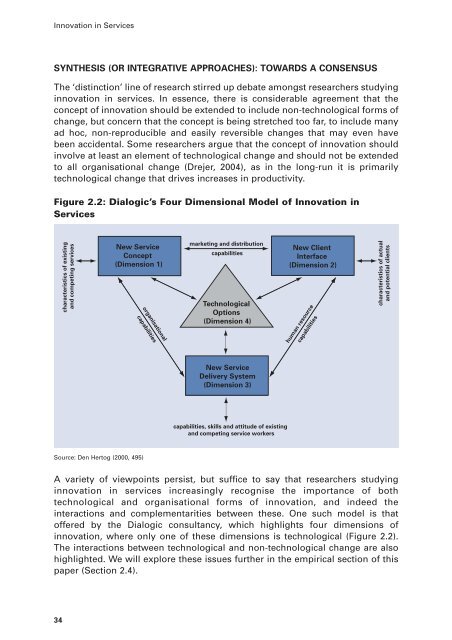Innovation in Services - Department for Business, Innovation and Skills
Innovation in Services - Department for Business, Innovation and Skills
Innovation in Services - Department for Business, Innovation and Skills
You also want an ePaper? Increase the reach of your titles
YUMPU automatically turns print PDFs into web optimized ePapers that Google loves.
<strong>Innovation</strong> <strong>in</strong> <strong>Services</strong><br />
SYNTHESIS (OR INTEGRATIVE APPROACHES): TOWARDS A CONSENSUS<br />
The ‘dist<strong>in</strong>ction’ l<strong>in</strong>e of research stirred up debate amongst researchers study<strong>in</strong>g<br />
<strong>in</strong>novation <strong>in</strong> services. In essence, there is considerable agreement that the<br />
concept of <strong>in</strong>novation should be extended to <strong>in</strong>clude non-technological <strong>for</strong>ms of<br />
change, but concern that the concept is be<strong>in</strong>g stretched too far, to <strong>in</strong>clude many<br />
ad hoc, non-reproducible <strong>and</strong> easily reversible changes that may even have<br />
been accidental. Some researchers argue that the concept of <strong>in</strong>novation should<br />
<strong>in</strong>volve at least an element of technological change <strong>and</strong> should not be extended<br />
to all organisational change (Drejer, 2004), as <strong>in</strong> the long-run it is primarily<br />
technological change that drives <strong>in</strong>creases <strong>in</strong> productivity.<br />
Figure 2.2: Dialogic’s Four Dimensional Model of <strong>Innovation</strong> <strong>in</strong><br />
<strong>Services</strong><br />
characteristics of exist<strong>in</strong>g<br />
<strong>and</strong> compet<strong>in</strong>g services<br />
New Service<br />
Concept<br />
(Dimension 1)<br />
Source: Den Hertog (2000, 495)<br />
organisational<br />
capabilities<br />
market<strong>in</strong>g <strong>and</strong> distribution<br />
capabilities<br />
Technological<br />
Options<br />
(Dimension 4)<br />
New Service<br />
Delivery System<br />
(Dimension 3)<br />
capabilities, skills <strong>and</strong> attitude of exist<strong>in</strong>g<br />
<strong>and</strong> compet<strong>in</strong>g service workers<br />
New Client<br />
Interface<br />
(Dimension 2)<br />
human resource<br />
capabilities<br />
A variety of viewpo<strong>in</strong>ts persist, but suffice to say that researchers study<strong>in</strong>g<br />
<strong>in</strong>novation <strong>in</strong> services <strong>in</strong>creas<strong>in</strong>gly recognise the importance of both<br />
technological <strong>and</strong> organisational <strong>for</strong>ms of <strong>in</strong>novation, <strong>and</strong> <strong>in</strong>deed the<br />
<strong>in</strong>teractions <strong>and</strong> complementarities between these. One such model is that<br />
offered by the Dialogic consultancy, which highlights four dimensions of<br />
<strong>in</strong>novation, where only one of these dimensions is technological (Figure 2.2).<br />
The <strong>in</strong>teractions between technological <strong>and</strong> non-technological change are also<br />
highlighted. We will explore these issues further <strong>in</strong> the empirical section of this<br />
paper (Section 2.4).<br />
34<br />
characteristics of actual<br />
<strong>and</strong> potential clients
















